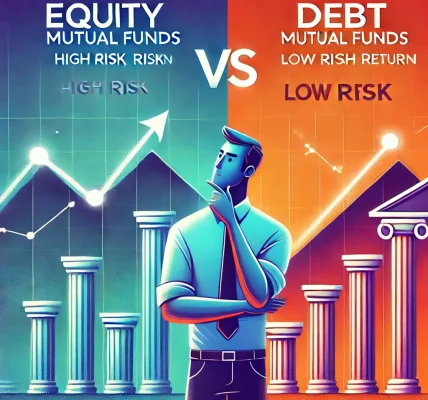Introduction
Mutual funds are one of the most popular investment vehicles due to their diversification, professional management, and potential for long-term wealth creation. However, like any investment, mutual funds come with their own set of risks. Understanding these risks is crucial for making informed decisions and safeguarding your investments.
In this article, we will explore the various risk factors associated with mutual funds, how they can impact your investments, and strategies to mitigate them.
1. Market Risk
Market risk, also known as systematic risk, arises due to fluctuations in the overall market. It affects all securities, including mutual funds, and is influenced by factors such as economic downturns, geopolitical events, inflation, and changes in interest rates.
Impact:
- The NAV (Net Asset Value) of mutual funds may decline during market downturns.
- Equity funds are particularly vulnerable to market risk.
Mitigation Strategies:
- Diversify investments across different asset classes (stocks, bonds, gold, etc.).
- Invest for the long term to ride out market volatility.
2. Credit Risk
Credit risk is the risk that a bond issuer in a debt mutual fund may default on interest or principal payments.
Impact:
- Debt funds that invest in low-rated securities are more vulnerable.
- A default can lead to a sharp decline in NAV.
Mitigation Strategies:
- Choose debt funds with high-rated (AAA) bonds.
- Check the credit rating of fund holdings before investing.
3. Interest Rate Risk
Interest rate risk affects debt mutual funds and occurs when market interest rates fluctuate. When interest rates rise, bond prices fall, negatively impacting debt mutual funds.
Impact:
- Long-duration debt funds are more sensitive to interest rate changes.
- Short-term debt funds experience lower volatility.
Mitigation Strategies:
- Invest in shorter-duration debt funds during rising interest rate scenarios.
- Consider dynamic bond funds that adjust portfolio duration based on market conditions.
4. Inflation Risk
Inflation reduces the purchasing power of money, and if your mutual fund returns do not outpace inflation, you may experience a loss in real value.
Impact:
- Debt funds are most affected as fixed returns may not keep up with inflation.
- Equity funds have the potential to provide inflation-beating returns over the long term.
Mitigation Strategies:
- Invest in equity-oriented funds for long-term growth.
- Consider inflation-indexed securities in your portfolio.
5. Liquidity Risk
Liquidity risk arises when a mutual fund faces difficulty selling its assets or investors are unable to redeem their units easily.
Impact:
- Funds investing in illiquid assets (small-cap stocks, corporate bonds) may have difficulty in redemption.
- In extreme cases, fund houses may temporarily suspend redemptions.
Mitigation Strategies:
- Invest in funds with a good liquidity profile (large-cap equity, government bonds, etc.).
- Check the fund’s exit load and lock-in period before investing.
6. Fund Manager Risk
Mutual funds are managed by professionals, but their decision-making can significantly impact fund performance. Poor investment choices or mismanagement can lead to underperformance.
Impact:
- Actively managed funds may suffer from fund manager bias or wrong stock selections.
- Inconsistent fund performance despite favorable market conditions.
Mitigation Strategies:
- Review the fund manager’s track record and experience.
- Consider passively managed index funds to eliminate human error.
7. Concentration Risk
Concentration risk occurs when a fund invests a significant portion of its assets in a single sector, stock, or asset class.
Impact:
- High exposure to one sector increases vulnerability to downturns in that sector.
- Less diversification leads to higher volatility.
Mitigation Strategies:
- Choose diversified mutual funds with exposure across multiple sectors and industries.
- Monitor the sectoral allocation of the fund regularly.
8. Foreign Exchange Risk (Currency Risk)
For mutual funds investing in international markets, fluctuations in foreign exchange rates can impact returns.
Impact:
- If the domestic currency depreciates, returns from foreign investments may rise.
- If the domestic currency appreciates, foreign investments may yield lower returns.
Mitigation Strategies:
- Invest in international funds with a hedging strategy to reduce currency risk.
- Diversify across both domestic and international markets.
9. Regulatory Risk
Changes in government policies, tax laws, or SEBI (Securities and Exchange Board of India) regulations can affect mutual fund performance.
Impact:
- Altered tax rules may change post-tax returns for investors.
- New regulations may impact fund management strategies.
Mitigation Strategies:
- Stay updated with regulatory changes and their impact on mutual funds.
- Diversify investments across tax-efficient options.
10. Exit Load and Expense Ratio Risk
Mutual funds charge fees like exit loads (charges for early redemption) and expense ratios (annual fees for fund management). Higher costs can reduce net returns.
Impact:
- High expense ratios can eat into investment gains.
- Exit loads may apply if you redeem units too soon.
Mitigation Strategies:
- Choose funds with lower expense ratios to maximize returns.
- Check the exit load structure before investing.
Conclusion
While mutual funds offer a great investment opportunity, it is essential to understand their associated risks. By diversifying your portfolio, monitoring fund performance, and aligning your investments with your financial goals, you can mitigate these risks and optimize your returns.
Before investing, conduct thorough research, read the fund’s offer document, and consult a financial advisor if needed. By being informed and cautious, you can navigate the risks effectively and build long-term wealth through mutual funds.
Happy Investing!



